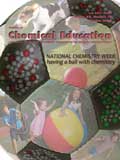from Erica Jacobsen, JCE High School Editor
The WonderLab Museum in Bloomington, IN was alive with movement and sound. Limber bodies snaked up a two-story maze called the “Grapevine Climber” to arrive triumphantly at the top. Massive soap bubbles burst, showering heads with a misty spray. Cheers and applause broke out as the centerpiece of a tall foam-block arch was successfully put in place. Participants gave in to the excitement of the museum—everyone was having a ball. The crowd that night? Chemistry educators attending the 2008 Biennial Conference on Chemical Education (BCCE). As I watch my own children interact with the world around them, I cherish their exuberance and willingness to let go and be in the moment without worrying about appearances or what someone else will think. That night at BCCE I felt free to act as my children would have.
I look forward to National Chemistry Week (NCW) because it provides a bigger stage and opportunity for all of us, no matter our age, to be exuberant about chemistry. The wording of the 2008 American Chemical Society (ACS) NCW theme personifies that idea—“Having a Ball with Chemistry”. The October 2008 issue of the Journal of Chemical Education, particularly the Chemical Education Today section, focuses on this universally appealing sports-related theme. The authors as well as JCE staff have made an enormous effort to present an array of ideas and activities that will excite you and your students as well as those around you.
With the sea of  blanketing October’s table of contents (indicating articles of interest to high school teachers), it is difficult to single out only an article or two to focus on. But here’s a great chance to dive into this issue anywhere and find something valuable.
blanketing October’s table of contents (indicating articles of interest to high school teachers), it is difficult to single out only an article or two to focus on. But here’s a great chance to dive into this issue anywhere and find something valuable.
And let’s think for a few minutes about next year’s NCW. I realize that when this issue comes out, you’ll still have about a month to gear up for this year’s celebration. But here at JCE, we’re already making plans for next year and invite you to join in the process. ACS offers the 2009 theme “Chemistry—It’s Elemental!” What articles would you like to see? What do you already use in your classroom that you could submit and share? Email me.
One easy way for everyone to participate is to first ask “What’s my favorite element?” Then, become a fan of that element online! You can become a “friend of the periodic table” and at the same time take an active part in the Division of Chemical Education social network online. It takes three steps:
-
Go to http://wiki.chemeddl.org/index.php/PTL:Elements_at_Facebook. Choose an element.
- If you’re not in facebook.com already, join by clicking on sign up and filling out the information on the right portion of the screen. (If you are in Facebook, just log in to Facebook at the URL in step 1.)
- You are now in Facebook. Go to Groups and request to join the Division of Chemical Education. When you are at the CHED Group page, click on: Become a fan of your favorite element. Select an element at http://wiki.chemeddl.org/index.php/PTL:Elements_at_Facebook. You will find a list of Links to element profiles at Facebook. Click on your favorite.
I chose titanium. You’ll see it mentioned in the October issue in connection with various sports equipment. But did you know it’s also part of M&M’s candy? Titanium dioxide is used to print the “m” on the candy.
Laura’s Take on the Issue
from Laura Slocum, JCE High School Associate Editor
I’m like Erica. NCW is one of my favorite times of the school year. It gives me the opportunity to be even more exuberant about my passion for chemistry. There are many ways to explore this year’s theme. A colleague encouraged me to “Have a BALL celebrating this year’s theme!!!” as he tossed a tennis ball at me. I have been collecting various types of balls to use for NCW throughout the summer; however, while reading Hawkes’s article I was reminded of a whole set of balls that I had not even considered—glass balls. Discussing glass and its properties with students often opens up lots of questions. I have found that glass is one substance they really like to explore, and the topic continues to raise questions long after we have completed the unit on states of matter. Hawkes’s article provided more depth for me in regard to the classification of glass—a solid or a liquid?—and it helped me to more broadly consider the many different types of glass. I think you will find his article really informative and enjoyable.




* You can follow any responses to this entry through the RSS 2.0 feed.